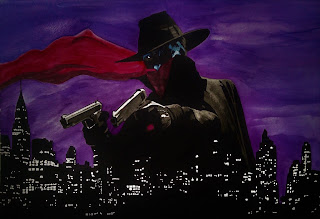LEGENDARY HEROES
#2 IN A SERIES
TARZAN
Edgar Rice Burroughs' novel "Tarzan of the Apes" first appeared in the October 1912 issue of All-Story pulp magazine. It was an adventure story set in darkest Africa, telling the story of an orphaned year-old boy, scion of the English House of Greystoke, who is adopted by a tribe of apes and raised by a fierce she-ape named Kala. The feral child is given the name Tarzan and grows up to become a protector of his adopted land. Compared to normal men Tarzan's strength, speed and stamina is almost super-human as he wrestles and defeats evil men, poachers, cannibals, gorillas, lions, crocodiles and sharks. Through the end of the 1930s Burroughs wrote 25 novels of Tarzan's exploits, many of them illustrated by J. Allen St. John. He married Tarzan to an American woman, Jane Porter, and they had a son named Jack who took the ape-name Korak for himself.
The popularity of the stories resulted in a 1918 film starring Elmo Lincoln. Six more silent movies followed, and with the introduction of sound a movie franchise was born in 1932. Olympic swimmer Johnny Weissmuller appeared in the first of his 12 Tarzan films, his last in 1948. Two movie serials were produced, one with Buster Crabbe and the other with Herman Brix (Bruce Bennett). All total there would be 44 live-action Tarzan movies with actors Lex Barker, Gordon Scott, Jock Mahoney and Ron Ely, and a successful Disney animated feature in 1999.
In 1921 Tarzan came to Broadway as a stage production, and a musical would debut in 2006 that would run for over a year. In 1929 Hal Foster began drawing the Tarzan comic strip for newspapers, which Foster did until 1937 when he launched his own creation "Prince Valiant". Noted illustrator Burne Hogarth took over the strip until 1950. Comic books initially reprinted the newspaper strips but from 1947-1972 Dell and Gold Key gave Tarzan his own magazine with new stories. In 1972 DC comics took over the comic book series with art supplied by Joe Kubert.
Tarzan came to radio in a 15-minute show that ran from 1932-1936 and again in 1951-1953. NBC brought Tarzan to TV with actor Ron Ely from 1966-1968, and there were several network cartoons featuring Tarzan over the years beginning in 1977. Tarzan's famous yell, often imitated by comedienne Carol Burnett, was a by-product of the first sound picture in 1932 and became a staple of all the movies that came afterward. The fearful jungle yodel was a combination of five sounds that included Weissmuller's own yell, a soprano singing high C, and a recording of a hyena's howl played backwards.

.jpg)


Comments
Post a Comment